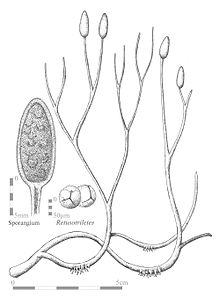Aglaophyton
| Aglaophyton Temporal range:
| |
|---|---|

| |
| Reconstruction of the sporophyte ofAglaophyton,illustrating bifurcating axes with terminal sporangia, and rhizoids. Insets show a cross-section of a sporangium and the probable spores. | |
| Scientific classification | |
| Kingdom: | Plantae |
| Clade: | Polysporangiophytes |
| Genus: | †Aglaophyton D.S.Edwards 1986[1] |
| Species | |
| |
| Synonyms | |
| |
Aglaophyton major(or more correctlyAglaophyton majus[2]) was thesporophytegeneration of adiplohaplontic,pre-vascular, axial, free-sporing land plant of theLower Devonian(Pragian stage, around410million years ago). It hadanatomicalfeatures intermediate between those of thebryophytesandvascular plantsortracheophytes.
A. majorwas first described by Kidston and Lang in 1920 as the new speciesRhynia major.[3]The species is known only from theRhynie chertinAberdeenshire,Scotland,where it grew in the vicinity of asilica-richhot spring,together with a number of associatedvascular plantssuch as a smaller speciesRhynia gwynne-vaughaniiwhich may be interpreted as a representative of the ancestors of modern vascular plants andAsteroxylon mackei,which was an ancestor of modernclubmosses(Lycopsida).
Description
[edit]
The stems ofAglaophytonwere round in cross-section, smooth, unornamented, and up to about 6mm in diameter. Kidston and Lang[3]interpreted the plant as growing upright, to about 50 cm in height, but Edwards[1]has re-interpreted it as having prostrate habit, with shorter aerial axes of about 15 cm height. The axes branched dichotomously, the aerial axes branching at a comparatively wide angle of up to 90°, and were terminated with elliptical, thick-walled sporangia, which when mature, opened by spiral slits, so that the sporangia appear to be spiral in form.[4]Sporangia contained many identical spores (isospores) bearing trilete marks. The spores may therefore be interpreted as meiospores, the product of meiotic divisions, and thus the plants described by Edwards and by Kidston and Lang were diploid, sporophytes. The plant was originally interpreted as a tracheophyte, because the stem has a simple central vascular cylinder orprotostele,[3]but more recent interpretations in the light of additional data indicated thatRhynia majorhad water-conducting tissue lacking the secondary thickening bars seen in the xylem ofRhynia gwynne-vaughanii,more like the water-conducting system (hydrome) ofmosssporophytes.Edwards[1]reinterpreted the species as non-vascular plant and renamed itAglaophyton major.
Aglaophytonis among the first plants known to have had amycorrhizalrelationship with fungi,[5]which formedarbusculesin a well-defined zone in the cortex of its stems.Aglaophytonlackedroots,and like other rootless land plants of the Silurian and early Devonian may have relied on mycorrhizal fungi for acquisition of water and nutrients from the soil.
The malegametophyteof the species has been formally described,[6]which was assigned to a newform taxonLyonophyton rhyniensis,but is now properly referred to as anAglaophytongametophyte. TheRhynie chertbears many examples of male and female gametophytes, which are loosely similar in their construction to the sporophyte phase, down to bearing rhizoids.[7]
Taxonomy
[edit]Aglaophyton majorwas first described asRhynia majorby Kidston and Lang in 1920.[3]In 1986 D.S. Edwards re-examined fossil specimens and reported that they did not contain truevascular tissue,but rather conducting tissue more similar to that ofbryophytes.As the diagnosis ofRhyniawas that it was avascular plant,he created a new genus,Aglaophyton,for this species. (The other species ofRhynia,R. gwynne-vaughanii,was not affected.) AsRhynia majorthe species had been placed in therhyniophytes,but no alternative higher level classification was proposed for the new genus.[1]
Phylogeny
[edit]In 2004, Crane et al. published acladogramfor thepolysporangiophyteswhich placesAglaophytonas a sister of thevascular plants(tracheophytes), with theHorneophytopsidabeing sister to both.[8]The basis of the cladogram is thatAglaophytonhas more developed conducting tissue than the Horneophytopsida, but does not have true vascular tissue.
References
[edit]- ^abcdeEdwards, David S. (1986), "Aglaophyton major,a non-vascular land-plant from the Devonian Rhynie Chert ",Botanical Journal of the Linnean Society,93(2): 173–204,doi:10.1111/j.1095-8339.1986.tb01020.x
- ^Strictly the name should have beenAglaophyton majus,as-phytonis neuter and the neuter ofLatin comparative adjectivesends in-us.Since February 2018, authors writing on theRhynie cherthave begun using the more correct form. SeeWellman, Charles H. (2018), "Palaeoecology and palaeophytogeography of the Rhynie chert plants: Further evidence from integrated analysis of in situ and dispersed spores",Philosophical Transactions of the Royal Society B,373(1739): 20160491,doi:10.1098/rstb.2016.0491,PMC5745327,PMID29254956and other papers in the same issue of that journal.
- ^abcdKidston, R. & Lang, W.H. (1920),"On Old Red Sandstone plants showing structure, from the Rhynie Chert Bed, Aberdeenshire. Part II. Additional notes onRhynia gwynne-vaughani,Kidston and Lang; with descriptions ofRhynia major,n.sp. andHornea lignieri,n.g., n.sp. ",Transactions of the Royal Society of Edinburgh,52(3): 603–627,doi:10.1017/s0080456800004488
- ^Remy, W. & Hass, H. (1996), "New information on gametophytes and sporophytes ofAglaophyton majorand inferences about possible environmental adaptations ",Review of Palaeobotany and Palynology,90(3–4): 175–193,Bibcode:1996RPaPa..90..175R,doi:10.1016/0034-6667(95)00082-8
- ^Remy W, Taylor TN, Hass H, Kerp H (1994), "4 hundred million year old vesicular-arbuscular mycorrhizae",Proceedings of the National Academy of Sciences of the United States of America,91(25): 11841–11843,Bibcode:1994PNAS...9111841R,doi:10.1073/pnas.91.25.11841,PMC45331,PMID11607500.
- ^Remy, W & Remy, R (1980)Lyonophyton rhyniensisn.gen. et nov. spec., ein Gametophyt aus dem Chert von Rhynie (Unterdevon, Schottland). Argumenta Palaeobotanica, 6, 37-72
- ^Taylor, T. N.; Kerp, H; Hass, H (2005), "Life history biology of early land plants: Deciphering the gametophyte phase",Proceedings of the National Academy of Sciences of the United States of America,102(16): 5892–7,Bibcode:2005PNAS..102.5892T,doi:10.1073/pnas.0501985102,PMC556298,PMID15809414.
- ^Crane, P.R.; Herendeen, P. & Friis, E.M. (2004), "Fossils and plant phylogeny",American Journal of Botany,91(10): 1683–99,doi:10.3732/ajb.91.10.1683,PMID21652317
